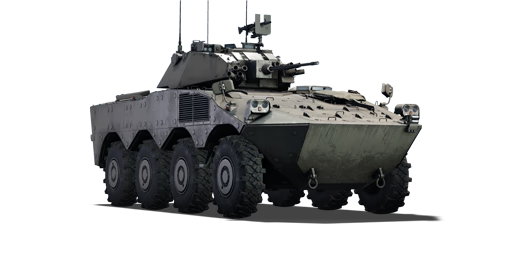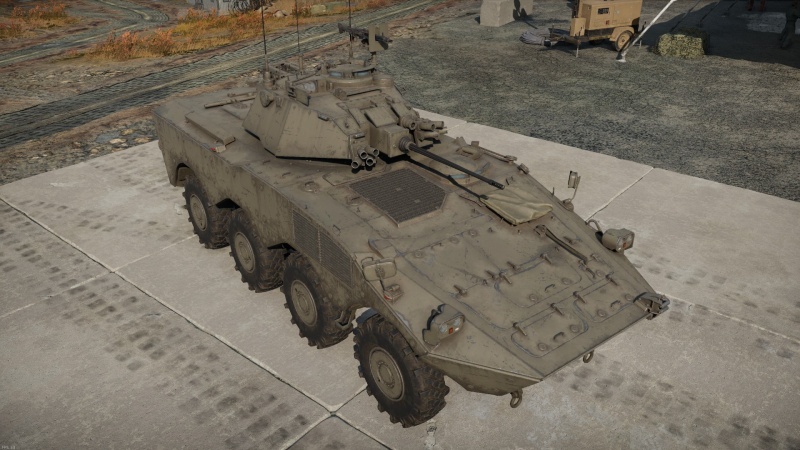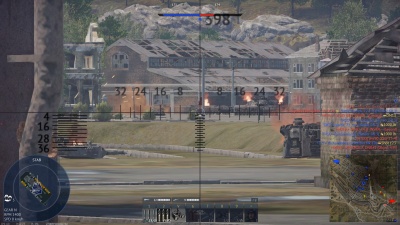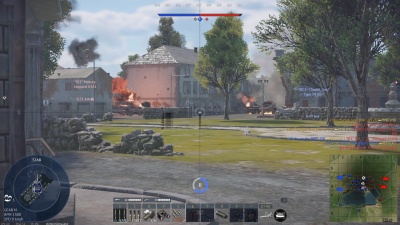VBC (PT2)
Contents
Description
The VBM Freccia is an Italian IFV designed by Iveco and OTO Melara for the Italian army with the aim of replacing the VCC-1 and VCC-2 armoured carriers that were previously in use. The vehicle's history dates back to the 1980s and 1990s when Italy was experimenting with the Centauro tank and modifying it for various roles, under the "VBC" program. Although the program was shelved, the idea resurfaced in the late 2000s, prompting Iveco and OTO Melara to revive their efforts. The VBC PT2 is the second prototype of the Freccia and features the TC-25 Hitfist turret, which is also present on the VCC-80 Dardo IFV. However, this vehicle does not include the ATGM, unlike the final product Freccia.
Introduced in Update "Danger Zone", the VBC PT2 is a highly effective platform, primarily due to its mobility and the empty space inside the vehicle that sometimes allows it to absorb enemy rounds unharmed. Role-vise, it is an all-rounder gank jeep, similar to the BTR-80A, but better in every way possible. The vehicle's armament includes a 25 mm Oerlikon autocannon (also seen on SIDAM) capable of firing a multitude of ammunition, including APFSDS rounds. It also has access to thermals and night vision devices, and players can take advantage of its favourable elevation and depression angles. However, since it is a wheeled vehicle, it may struggle off-road depending on the map. Additionally, since it is a large platform, it cannot hide easily, making mobility key to its effectiveness. The VBC PT2 can perform well against enemy aircraft, but players need to be close to the battlefield for the gun to reach targets, and it is best not to reveal the vehicle's position unless players are certain they can do damage. Overall, the vehicle is well-equipped for its battle rating and highly effective, but players may struggle initially without certain modules unlocked. Therefore, it is advisable to stick with more heavily armoured allies when initially deploying the vehicle.
General info
Survivability and armour
The VBC (PT2) has enough armour to protect it against heavy machine gun fire (the sides are still vulnerable at ranges below 200 m when standing completely flat) and may sustain low level 20 mm autocannon fire frontally. Enemies do not use APHE as much anymore, so it is more likely to lose only 1 crew member instead of 2, but it is still vulnerable to APHE nonetheless. The back of the hull is also very empty, so it can be used as a bait. Due to this, it is quite well suited to facing other lightly armoured vehicles and will be able to take a beating from medium tanks as long as it's not hit in any important modules.
The machine will not be able to withstand high-calibre rounds such as APFSDS or HEAT shot by MBTs head-on. Overpressure is also a concern, as even HEAT-FS can overpressure the entire vehicle if it hits the very roof or the very bottom (indents near wheels).
Any driver of this prototype is advised to keep in mind what type of damage an enemy can do to make the most out of car's armour when it's possible and to not completely rely on it for every engagement. Even in Arcade mode, where crew replenishment may protect the car from one fatal shot, it will still explode if shot straight into the middle.
The car makes up its weaknesses by having more awareness-related devices than its opponents. It is one of the earliest vehicles to obtain Laser Warning System - if a modern tank uses laser rangefinder anywhere near it, or a modern ATGM vehicle will aim laser pointer at it, the commander will immediately find out that they are being targeted and where from. Then, car can be moved out of the way of a shell in the second that it takes the shell to reach it. Likewise, car may drop smoke shells to disrupt helicopter automatic aim or to screen itself against an ATGM tank.
There are 4 groups of aerosol smoke grenades which are fired in turret direction. They can be easily used to shield the car from any vigilantes coming from the back (by firing them back and then driving a bit forward to properly deal with the current target), or to simply break visual contact and annoy pursuers while driving away.
Armour type:
| Armour | Front (Slope angle) | Sides | Rear | Roof |
|---|---|---|---|---|
| Hull | 72 mm | 15 mm Top 30 mm Bottom |
30-50 mm | 10-15 mm |
| Turret | 25-40 mm Turret front 22 mm Gun mantlet |
40-6 mm | 40 mm | 25-40 mm |
| Cupola | 40 mm | 40 mm | 40 mm | 25 mm |
Notes:
Mobility
The VBC is equipped with a powerful 520 hp engine that is capable of taking this vehicle to a top speed of 110 km/h. Should it need to back out, it has a 40 km/h reverse gear available, which is very effective if it is an emergency.
At a stock stage, the car is only slightly faster than the BTR-80, being on average slightly slower than medium tanks, so some planning will be required to flank them properly.
Thanks to its six steerable wheels, it can change direction quickly, accurately and effectively without bothering the aiming. The wheels and excellent suspension ensure that the VBC can operate smoothly on all surfaces.
One of the car weaknesses is a poor engine damage retention. Should the engine be broken, vehicle will barely be able to drive 18 km/h until completely fixed, which is practically a death sentence if it is stuck in the middle of nowhere.
| Game Mode | Max Speed (km/h) | Weight (tons) | Engine power (horsepower) | Power-to-weight ratio (hp/ton) | |||
|---|---|---|---|---|---|---|---|
| Forward | Reverse | Stock | Upgraded | Stock | Upgraded | ||
| Arcade | 121 | 25 | 26 | 806 | 1,049 | 31 | 40.35 |
| Realistic | 109 | 23 | 460 | 550 | 17.69 | 21.15 | |
Modifications and economy
Armaments
Main armament
The main weapon is a 25 mm cannon found previously on SIDAM. Even at it's baseline level, it deals the same damage as a 30 mm found on the BTR-80A, but at 2 times the fire rate, put on a very fast rotating turret and is able to aim 10 degrees down, so the weapon is now easy to use and has no blind zones. The weapon is also additionally stabilised and will be absolutely accurate up until 65 km/h (and practically always stable in AB due to tank crew compensating for the wobble). For additional ease of aim, laser rangefinder can be unlocked (paired with LWS). All of this makes the car able to easily intercept enemies both at close and long range.
The gun can overheat after firing about 60 shells in a quick succession, putting the gun on forced reload. This should be avoided, as the belt itself is not actually reloaded and car will be stuck with only 40% or less of the belt against whoever it was fighting before.
Whenever stuck with no ammo left in a current belt, gunner can "hot switch" to another loaded belt of a different composition. This takes only 1 second and is better than waiting for reload, practically increasing vehicle's ready anti-tank ammunition pool to 200 with 100 HE shells on the side for aircraft. The swapped belt must be "loaded" for this to work. The swap wont properly work during overheat reload and will only waste time.
Unlike SIDAM, VBC prototype is allowed to carry as much APDS as it wants to upon unlocking the pure APDS belt, and the APDS is able to terminate almost any european tank through the hull from the side in 5 to 10 hits and taking some more shells to destroy Soviet-style tanks, unless shells hit them directly into fuel tanks. An attack from behind will turn any tank into scrap within 4 shots with rare exceptions. While the fire rate isn't as overwhelming as SIDAM (it's only one cannon), any half-decent focused aim should destroy the target if it exposes the hull even a little bit.
At last stages of research, APFSDS becomes available. This doesn't fundamentally change how the vehicle works, but significantly increases angled and flat penetration of the shells. Against any tank, it means that enemy engine is now always accessible. It also allows to obliterate Soviet tanks at shallow angles without any chance of them randomly surviving and gives a real fighting chance against American and Israeli tanks, which could normally shrug off normal APDS. There is also a minor chance of hitting other light tanks through a dead tank, but this shouldn't be relied upon.
Even with APFSDS, the 25 mm is not a godlike weapon and it can't penetrate frontal armour of brawler tanks. If target is not immediately vulnerable, a short burts towards tank cannon will put it into "red" state and will likely make the opponent either whiff a shot or retreat. The same goes for enemy tracks - a short burst of APDS will turn over any tank, ruin their aim and expose them.
| 25 mm Oerlikon KBA B02 | Turret rotation speed (°/s) | Reloading rate (seconds) | ||||||||||||
|---|---|---|---|---|---|---|---|---|---|---|---|---|---|---|
| Mode | Capacity (Belt) | Fire rate | Vertical | Horizontal | Stabilizer | Stock | Upgraded | Full | Expert | Aced | Stock | Full | Expert | Aced |
| Arcade | 400 (100) | 560 | -10°/+60° | ±180° | Two-plane | 54.5 | 75.5 | 91.7 | 101.4 | 107.9 | 10.40 | 9.20 | 8.48 | 8.00 |
| Realistic | 34.1 | 40.1 | 48.7 | 53.9 | 57.3 | |||||||||
Ammunition
- Default: APDS · HEI-T* · HEI-T*
- M792: HEI-T* · HEI-T* · HEI-T*
- M791: APDS · APDS · APDS
- PMB 090: APFSDS
| Penetration statistics | |||||||
|---|---|---|---|---|---|---|---|
| Ammunition | Penetration @ 0° Angle of Attack (mm) | ||||||
| 10 m | 100 m | 500 m | 1,000 m | 1,500 m | 2,000 m | ||
| APDS | 80 | 79 | 73 | 67 | 61 | 55 | |
| HEI-T* | 7 | 6 | 4 | 3 | 3 | 3 | |
| APFSDS | 92 | 90 | 83 | 75 | 62 | 58 | |
| Shell details | ||||||||||||
|---|---|---|---|---|---|---|---|---|---|---|---|---|
| Ammunition | Velocity (m/s) |
Projectile mass (kg) |
Fuse delay (m) |
Fuse sensitivity (mm) |
Explosive mass (TNT equivalent) (g) |
Ricochet | ||||||
| 0% | 50% | 100% | ||||||||||
| APDS | 1,335 | 0.13 | - | - | - | 75° | 78° | 80° | ||||
| HEI-T* | 1,100 | 0.19 | 0.1 | 0.1 | 54.4 | 79° | 80° | 81° | ||||
| APFSDS | 1,385 | 0.1 | - | - | - | 78° | 80° | 81° | ||||
Ammo racks
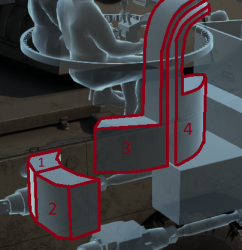
| Full ammo |
1st rack empty |
2nd rack empty |
3rd rack empty |
4th rack empty |
Visual discrepancy |
|---|---|---|---|---|---|
| 4 | 3 (+1) | 2 (+2) | 1 (+3) | 0(+4) | No |
Machine guns
The machine guns have a rather high fire rate and can be used to suppress aircraft while also firing the main weapon at them.
| 7.62 mm Beretta MG42/59 | ||||
|---|---|---|---|---|
| Mount | Capacity (Belt) | Fire rate | Vertical | Horizontal |
| Coaxial | 4,600 (200) | 801 | N/A | N/A |
| Pintle | 2,000 (200) | 801 | -8°/+20° | -160°/+60° |
Usage in battles
The VBC PT2 combines features of the Centauros, SIDAM and the Dardo IFVs to make a better BTR-80A, so it's best to play this vehicle as either an agressive flanker or a support to your more armoured allies. The VBC is wheeled, meaning that whenever it finds a road it's able to go at much higher speeds compared to many other vehicles at the battle rating. It is best to stick with allies when possible if you are planning to fight enemies head-on.
When playing stock as the VBC PT2, it might be hard to earn points, as majority of the speed and firepower aren't there yet, but you can still be useful by actively scouting enemy players and attacking enemy aircraft, which the 25 mm cannon is more than capable of dealing with. The VBC can also work well in late game, when capturing points is essential to getting the victory, making the most out of its mobility.
As an example of a flanker role with full APDS belt, the VBC at times can be used effectively in urban combat. If you pick a side street to set up, when the enemy goes past (hopefully without seeing you), you will be able to hit them in the side with your main 25 mm cannon. Sometimes, you can even do a drive-by attack and finish them off by firing APDS into the engine deck. By doing this you can become quite the annoyance to the enemy team as there's not much they can do to stop you, as the car moves faster than turret tracking of most tanks. If you've been spotted, however, you will need to move away as quickly as possible to avoid being cornered. The VBC, although being fast, is not very survivable. Its armour is only good against machine gun fire (don't forget to angle the hull when flanked by an MBT!) and low level autocannon fire from the front. An adequate enemy MBT will make short work of you if they know where you are. One of the many weaknesses of the VBC is the fact that it also has a big profile which usually means hiding is not possible at times, so using teammates as a distraction, or smoking up your back is often necessary. Using a difficult to see vantage point could also help:
Upon researching laser rangefinder, the car can flank over great distances as well. It's no secret that a lot of snipers and light tanks do not like to fire on the move, especially broadside, so you can figure out their routes towards the sniping spot and intercept them by firing on their sides from 1.2 km or further. At worst, you can give them a pause and destroy their engine, then point them out for your allies and leave. At best, you will be able to destroy one or more of them outright, but you should never overstay your welcome, as even one angry sniper might precisely point out your position for others, or even destroy you himself. If your long range aim is terrible and you need some hard practice, you can go to Assault arcade mode and try to flank the spawning NPCs (This will also let you realize, that even top rank tanks have to fear the 25 mm shells, which will become relevant in the future)
Once you research the important modifications for this vehicle (both APDS and APFSDS, mobility and thermals), your offensive capabilities are greatly improved. The VBC has a 25 mm Oerlikon-Buhrle cannon of SIDAM, so you can expect similar anti-tank performance. The stock belt for the 25 mm cannon is not too good at dealing with ground enemies, but once the APDS or APFSDS belt is unlocked, the VBC PT2 can easily make short work of MBTs and light vehicles from the sides or the rear, sometimes even at extreme angles. Many of the tanks in full downtier are just food for the VBC and can't sustain even frontal attack, for example German 8.0 tanks stand literally no chance against it if it fires first, as it can literally double tap them through the turret. Sadly, unlike the future Freccia, the VBC doesn't have ATGMs, so some vigilance is required even when having an upper hand, as at any moment more armoured foes could present themselves. In such case, remember the lessons of the BTR-80A - dismantle difficult opponents, then go behind them to finish the job or call allies (or even just bomb them when playing Arcade).
Other neat additions that will greatly aid you is the VBC's thermal imaging device made by Kollsman and the LWS. Although only available for the gunner, thermal sight is a great asset that you'll be able to use once unlocked to easily pick out and spot enemies outright (it works during the day, too!). The Laser Warning System is a purely defensive device, which will alert you when an enemy vehicle is lasing you, such as when laser rangefinding or guiding laser-guided missiles. This doesn't automatically mean that you will know when old tanks or some SAM are firing a missile at you, as they sometimes use different guidance method. Anything that does use laser is inherently lethal and should be dodged immediately. It is also important to remember, that some laser missiles and bombs can be launched in "blind" and pointed towards the car at the last 5 seconds, so dropping the smoke screen and running away is imperative for survival when hunted by helicopters or "space bombers".
Pros and cons
Pros:
- Fast-firing 25 mm cannon
- Potent sub-calibre rounds allow to snipe tanks at sharp angles and penetrate normally invincible MBT at closer ranges
- Superb mobility
- Light protection against HMGs and low-level 20 mm autocannon fire
- LWS can save it from a random airstrike or snipe in an uptier
- Can fire behind itself without major obstructions
Cons:
- Weak against high calibre projectiles
- Not the best off-road mobility
- High profile
History
The history of the OTO Melara/Iveco VBC begins during the late stages of the Cold War. In 1995, shortly after the development of the B1 Centauro tank destroyer made by OTO Melara and Iveco, Italy would begin to show interest in what they could do to the design of the Centauro to allow it to be used for different roles and scenarios. This was partially due to Italy finally being somewhat independent in its military industrial complex, which allowed more homegrown designs to be put into service. Whilst the Cold War had been raging on, Italy had begun to rapidly re-arm itself mainly due to the post WW2 laws no longer being in effect, and Italian companies such as OTO Melara became able to continue work on military projects.
As the B1 Centauro was being produced, the Ministry of Defense would green-light a set of programs that would aim to modify and equip the Centauro with many different weapon systems to fit different roles which would make it more versatile. One of them would be named "VBC", standing for "Veicolo Blindato da Combatimento" (armoured vehicle for combat in English). The first vehicles which came out of the VBC program would firstly only have slightly modified B1 Centauro hulls, one would go on to mount the OTO TC 20 turret, it was armed with an automatic 20 mm Rheinmetall Rh202 cannon, at the time the turret was installed on the Fiat 6616. Another variant would install what was known at the time as the OTO TC 25 Hitfist turret, this was armed with an Oerlikon KBA 25 mm automatic cannon. This turret was already installed on the VCC-80 'Dardo' infantry fighting vehicles. These vehicles would be shown extensively during military vehicle expos but ultimately did not generate any interest so a different design would be made in hopes for it to be picked up. The next vehicle which was also known as the VBC under that program would instead have a heavily modified hull, the main changes would be the introduction of a proper space for infantry to be carried at the back of the vehicle and the new weapon system known as the OTO 60 mm HVMS. This sadly would not be picked up and development would begin to slow down.
Fast forward to the early/mid 2000s, and OTO Melara alongside Iveco would showcase a new prototype of IFV which would also be known as the VBC. This would be the second prototype which would use a lot of the technical know-how gained during the early stages of the program. The main differences would be an entirely new hull, and it only shared a few things to the hull it was based off. The crew compartment would be remade to allow for more room, the protection of the vehicle also increased. In terms of speed, it got a new engine and was able to go over speeds of 105 km/h on roads. Off-road it still held its own but naturally being wheeled meant that it had a harder time compared to its tracked counterparts. The vehicle would be much taller and wider than a standard B1 Centauro, it would fitted with the latest technology but for testing purposes, OTO Melara opted to arm the prototype with the OTO TC 25 Hitfist turret which was still used by the VCC-80 'Dardo'. The turret was the exact same for the most part, for example the ability to mount TOW ATGMs was kept and also used during testing, the only difference from the standard Dardo turret was the additional 7.62 mm machine gun attachment on top of the turret roof. This vehicle would eventually be better known as the "Freccia IFV" prototype. After rigorous testing OTO Melara decided to finally remove the Dardo turret and substitute it with a more modern turret which was able to fire Israeli-made Spike ATGMs. Eventually the Italian army would decide to make an order for the vehicle and by 2009 the Freccia IFV was in full time service.
Devblog
Following the procurement of the Centauro into service by the Italian armed forces, the designer consortium, made up of the IVECO and OTO Melara companies, continued work on the design in an effort to create further, complementing variants. One such variant would be conceived as an IFV, equipped with a further developed turret used on the tracked Dardo IFV, which would later become the Hitfist turret.
Based on a modified Centauro chassis and fitted with the new turret designed by OTO Melara, the first prototype of the new IFV design was constructed and handed over for testing to the Italian army in 1996. As the testing was deemed successful, the Italian army placed an initial order calling for 249 units of various modifications to be manufactured in 2006, thus officially adopting the design into service. Simultaneously, the new vehicle received the official designation 'Freccia' (eng. Arrow) in Italian service.
The Freccia represents the spearhead of the Italian light armored units and is among the most advanced vehicles in service with the Italian forces. Outside of the military exercises, the Freccia has not taken part in any active combat operations and Italy remains its sole operator until the present day.
Media
- Skins
See also
- Freccia - Final form of this car
- Type 87 RCV - Similar tank in Japanese tech tree
External links
| Italy light tanks | |
|---|---|
| Italy | |
| L6/40 | L6/40 · L6/40 (31 Rgt.) |
| M11/39 | M11/39 |
| Autoblindo | AB 41 · AB 43 |
| Fiat 6614/6616 | FIAT 6614 · AUBL/74 · AUBL/74 HVG |
| R3 Capraia | R3 T106 FA |
| Centauro | Centauro I 105 · Centauro I 105 R · Centauro I 120 · Centauro RGO · VRCC |
| Freccia | VBC (PT2) · Freccia |
| Dardo | Dardo · VCC-80/60 · VCC-80/30 |
| Other | C13 T90 |
| USA | ▄M3A3 · ▄M24 · ▄M18 |
| Hungary | |
| WWII | Csaba · Toldi IIA |
| Post | ◔BTR-80A · KF41 |


